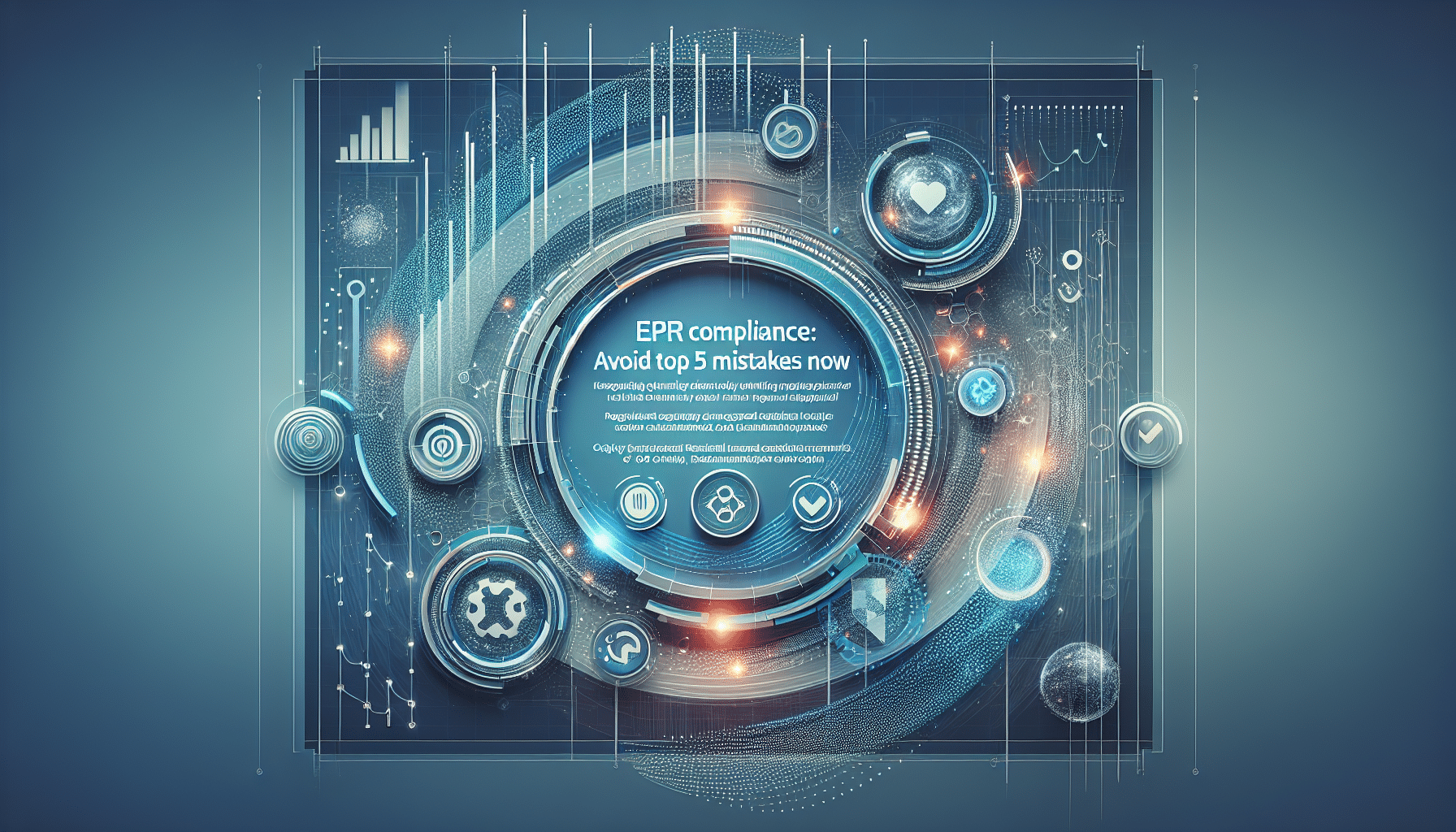About eldris
epr.eldris.ai leads the EPR sector, in fast, automated, AI Agent EU packaging, WEEE, and Battery Compliance for Brands, E-Commerce and Service based businesses expanding into the EU.
In This Article
- Understand EPR obligations and categories (packaging, WEEE, batteries)
- Register with relevant authorities in every market you sell in
- Don’t assume marketplaces cover your compliance—verify every detail yourself
- Use AI compliance management tools to streamline operations
- Stay ahead of impending EU packaging laws changing in 2025
- Consult with advisors to ensure cross-border harmonisation
- Maintain always-on EPR awareness to protect your e-commerce presence
Understanding EPR Compliance for Online Sellers
Why EPR Matters in 2024
Extended Producer Responsibility, or EPR Compliance, has become a vital legal obligation for e-commerce businesses selling within the EU. In a nutshell, EPR mandates that producers—including online sellers—take responsibility for the entire lifecycle of the products they introduce into the market. This includes packaging, electronic goods, batteries, and several other regulated categories.
With the increasing emphasis on sustainability and circular economy principles, EPR Compliance ensures that companies absorb the environmental costs of their products and packaging. This initiative aligns with various European environmental directives, shaping a greener future. For online sellers, failure to comply can result in severe penalties, including account suspension, hefty fines, and brand damage.
Given how dynamic regulations are and how they vary from country to country within the EU, online sellers must be proactive in achieving and maintaining their EPR Compliance. Especially in 2024, enforcement efforts from both the EU and national authorities are intensifying, making it crucial to stay updated and properly registered. Learn more about Marketplace and E-commerce Compliance

The Most Common EPR Mistakes Online Sellers Make
Top Pitfalls to Avoid Immediately
Despite the abundance of digital resources available, online sellers continually fall into the same EPR Compliance traps. Below are the top pitfalls businesses must avoid to steer clear of regulatory trouble:
1. Assuming Marketplaces Handle Compliance: Many sellers mistakenly believe that platforms like Amazon or eBay manage all EPR obligations on their behalf. While these marketplaces facilitate compliance, the ultimate legal responsibility still lies with the seller.
2. Ignoring Country-Specific Obligations: EPR regulations are not standardised across the EU. Each country may have its own requirements for registration, reporting, and fee structures. This complexity can result in non-compliance even when sellers think they’re covered.
3. Failing to Register with National Authorities: Registration with relevant country-specific authorities is the foundation of EPR Compliance. Sellers who bypass this step or register inaccurately can face backdated fines and reporting obligations.
4. Neglecting EPR Categories: Sellers often forget that EPR doesn’t just apply to product packaging. Waste Electrical and Electronic Equipment (WEEE), batteries, and textiles may also fall under EPR obligations depending on what’s being sold.
5. Poor Document Management: Sellers frequently fail to retain or organise their compliance documentation. In the event of an audit, poorly maintained records can result in both financial and legal consequences.
“Many sellers realise too late that compliance gaps can halt their sales across European marketplaces. Being reactive is no longer viable—proactive EPR Compliance is the only way forward.”
EU Packaging Rules: What You Must Know
The EU Packaging Directive has been updated to demand more transparency and responsibility from manufacturers and sellers. This includes proper labelling, sustainable materials, and detailed reporting of material weights and types.
Under EPR, sellers must calculate and report packaging waste broken down by material—such as cardboard, plastic, and aluminium. This data must then be submitted to authorised organisations like PROs (Producer Responsibility Organisations) in each selling country. Non-compliance may lead to backdated penalties and delisting from online marketplaces.
Sellers must also consider the recyclability and disposal guidance of their packaging. Changes coming into effect by 2025 will further require harmonised labelling and the usage of recycled content. Staying EPR-compliant today means future-proofing your packaging processes for tomorrow’s regulations.
WEEE Compliance Requirements Explained
WEEE—Waste Electrical and Electronic Equipment—is a crucial part of EPR Compliance for sellers who handle electronics or electronic accessories. If your products contain batteries, plugs, or electrical components, you must satisfy specific WEEE obligations in each EU country where these items are sold.
These requirements involve registering as a WEEE producer, reporting units sold, and financing the take-back schemes and recycling of old devices. In some countries like Germany, WEEE compliance requires working with authorised representatives and includes displaying unique identification numbers (e.g., WEEE-Reg.-Nr.DE).
For non-compliant sellers, marketplaces will block listings or even suspend accounts to avoid liability under local laws. Read a related article It’s essential to seek expert help or automated toolsets to handle classification, registration, and reporting correctly the first time around.
Amazon Seller EPR Registration Mistakes
Sellers on Amazon’s European marketplaces face additional scrutiny under EPR regulations. As early as 2022, Amazon began actively suspending listings for sellers who failed to provide valid EPR registration numbers. This initiative has only intensified since.
Common mistakes include uploading invalid registration details, using a proxy or reseller’s numbers, or failing to update expired registrations. Amazon does not offer direct EPR services, so while they enforce the rules, sellers are expected to manage compliance independently.
To remain operational and maintain Buy Box eligibility, Amazon sellers must upload valid numbers for packaging, WEEE, and battery obligations via Seller Central. Failure to do so may result in warnings and eventual listing deactivation.
How AI Tools Help Simplify Compliance
Today’s e-commerce sellers operate in an increasingly regulated space. Navigating dozens of different EPR requirements can be daunting. That’s where AI-driven compliance solutions offer tremendous value. Automated systems can track regulatory changes across countries, flag missing registrations, and even populate reporting data based on your product inventory and shipment volumes.
By integrating artificial intelligence into your back-office processes, you can reduce human error, avoid duplication, and cut hours of manual work per month. Furthermore, some AI tools offer risk alerts and scenario planning, identifying the most cost-effective compliance pathways for multi-country sellers.
The benefits of AI extend beyond accuracy—they ensure timeliness. Outdated reports, incorrect packaging volumes, or country-specific classification errors are all flagged before submission deadlines lapse. This fosters a resilient compliance culture suited for the digital age.
Meeting the 2025 EU Packaging Deadline
Major updates are coming in 2025 that will impact virtually every online seller. The EU is tightening the legal thresholds for sustainable packaging under EPR rules. These changes include mandatory recycled content targets, clearer disposal labelling, and full harmonisation of producer registration databases across the union.
To meet these deadlines, sellers must act now. Begin by revisiting your packaging supply chains and auditing packaging weights. Work with a compliance advisory service to ensure every wrapped parcel meets the new recyclability benchmarks.
Failure to meet these standards means your packaging may soon be non-compliant—risking product bans, customer complaints, and platform suspensions.
How Our Advisory Services Support You
Managing EPR Compliance isn’t just a checkbox. It requires a full understanding of local laws, ownership of responsibility, and real-time tracking of obligations. Our advisory services provide expert oversight and flexible solutions tailored to your inventory and shipping footprint.
We begin with a diagnostic, evaluating your compliance gaps across countries and product types. From there, we facilitate necessary registrations, select your best-suited PROs, and offer reporting templates that align with each nation’s legal framework.
For businesses seeking scale, our AI-powered dashboard consolidates all EPR data into a single, intuitive platform. Compliance ceases being a burden and becomes a strategic advantage.
Checklist for Staying EPR Compliant in Europe
A successful compliance strategy is proactive, systematic, and iterative. Here is a checklist every seller must reference monthly:
- Register as an EPR producer in each destination country
- Track product categorisation (WEEE, packaging, batteries, etc.)
- Submit data to the appropriate PROs or authorities
- Maintain a secure archive of compliance documentation
- Audit your packaging for material splits and recyclability
- Keep EPR numbers updated within Amazon and other platforms
- Use automation tools to manage monthly reporting cycles
- Stay ahead of 2025 Packaging Directive changes
- Leverage expert services for cross-border optimisation
- Monitor new legislation via credible regulatory feeds Top 5 seller mistakes you should avoid
Conclusion: Future-Proofing Your E-Commerce Business
[CONCLUSION_CONTENT]
Looking ahead, EPR Compliance is set to become even more critical. Authorities and marketplaces are closing loopholes and levelling regulations across borders. For online sellers, this isn’t just about avoiding fines—it’s about building consumer trust, maintaining seller account stability, and contributing to a sustainable economy.
The time to act is now. You must integrate EPR obligations into the fabric of your business, not treat them as an afterthought. The risks of falling behind include not just financial penalties, but the loss of credibility and restricted access to some of the world’s most dynamic e-commerce markets.
With the right tools, advisory support, and dedication to sustainability, modern sellers can navigate the EPR landscape with confidence. Take the first step: register, report, and remain ever aware.
Great guide on top-5-epr-pitfalls-and-how-to-avoid-them-as-an-online-seller-interactive-we-reveal-the-top-compliance-mistakes-online-sellers-make-and-how-our-advisory-and-registration-tools-help-you-steer-clear-o – Community Feedback










